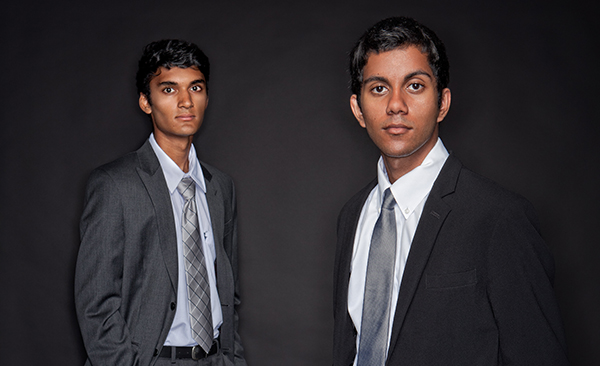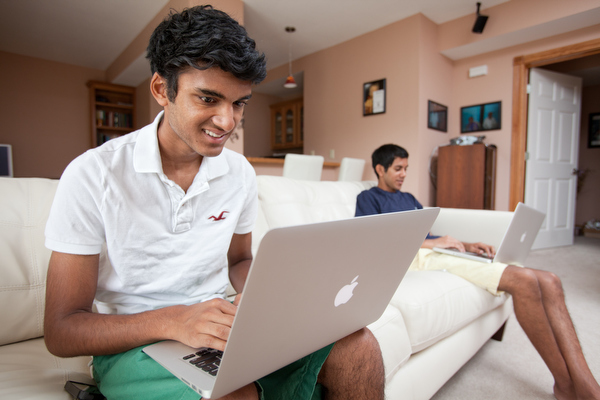Boys 2 Men

For several weeks this spring, Nahush Katti and Vikram Arunachalam Arun stayed at the office until nearly midnight to work on a business plan for DoctorOn, their teleophthalmology company, in preparation for a big pitch in Palo Alto, Calif.
They raided the Keurig coffee machine in their shared office space in the Downtown Incubator. They brought in a mini basketball hoop and played quick games of HORSE with each other when they needed a break from the grind.
The grueling schedule is not so different from that many new entrepreneurs endure, but there is one thing about these aspiring biomedical engineers that makes them stand out. Katti and Arun’s days were filled not with jobs or family obligations but with attending classes as Rock Bridge High School seniors.
Developing DoctorOn
The interest in telemedicine was prompted by stories of the difficult commute Katti’s grandfather endured for medical care in rural India, where he commuted two to three hours each way to see a doctor. Arun notes that “everything else is online,” so the two thought, why not medical care? Out of this discussion came the idea of DoctorOn, a digital concierge doctor. The business idea has undergone a few shifts as it progressed from the broad field of telemedicine to the more specific field of teleophthalmology. Because ophthalmology is heavily dependent upon imaging, that diagnostic technique seemed to be most easily replicated on a phone.
Two components form the basis of the DoctorOn device: a small machine called iOn which manipulates light into a slit and is designed to be attached to a smartphone; and an app, which walks the user through the necessary steps, utilizes the smartphone’s camera to capture images and sends the images to a professional to be read. One will be able to buy DoctorOn (app and iOn attachment) and a noncontract smartphone for about one-tenth the cost of the low end of current machines capable of producing the same diagnostic images of the eye. And DoctorOn is much more easily transported into rural areas.

The DoctorOn technology focuses on diagnosing cataracts, one of the leading causes of blindness around the world. Katti and Arun have partnered with Sankara Nethralaya charitable eye hospital, one of the largest eye hospitals in India. This partnership allows patient trials using DoctorOn. The two young men were able to go with professionals there on a trip to a village in rural India and see the first prototype of their invention being utilized to care for people who had never had access to eye care in their lives.
Both Katti and Arun split their time between the technological and business parts of DoctorOn. Arun says that learning things on their own makes the process fun, and Katti loves to figure out a difficult problem and then be able to implement the solution and see it work.
In April, Katti and Arun competed in a pitch presentation at the Indo-US Science and Technology Forum in Palo Alto. They were one of 10 businesses picked out of 300 applicants to compete for funding. Although they did not win funding, they gained additional experience and contacts and remain diligent in pursuing new leads for funding.
Lots of local support
In addition to the support of their parents, Katti and Arun have experienced a great deal of encouragement and assistance from the Columbia business community. The summer after their freshman year of high school, the two participated in Innovate 100 thanks to Keith Politte, entrepreneurship mentor and TEDxCoMo producer. They found the environment at this workshop “electric” and life changing. They were first runners-up in the professional pitch slam, an invaluable validation.
They knew they had a decent idea, but they credit the exposure to other ideas and businesses and other enterprising young entrepreneurs and the connections they made as pushing them to try to make their idea into a reality. Katti recently presented as part of TEDxCoMo, an independently organized conference of the popular idea-oriented phenomenon.
Mike Brooks, president of Regional Economic Development Inc., helped them get office space and has provided ongoing guidance. Alex Madinger, a recent University of Missouri graduate in mechanical engineering whom they met at the Incubator, helped with the design of the iOn and got a prototype printed. The iOn prototypes were printed using 3-D printing technology at the Columbia Area Career Center and at MU’s College of Engineering Prototype Development Facility. Dr. Jim Gann, director of technology and business development with MU Extension, has provided them with many contacts and traveled with them to Palo Alto after working together on their presentation skills and helping them edit their business plan.
Being high school students has also come in handy: Rock Bridge High School’s EEE program offers an internship program, so during their senior year, the two enrolled in a course called Advanced Seminars and Investigations, for which they received course credit for working on DoctorOn at school.
‘It’s not a project’
This fall the DoctorOn co-founders will attend different universities, but they plan to continue to grow the company. Katti plans to study biomedical engineering at Purdue University, and Arun plans to enroll in a five-year program at Washington University in St. Louis, during which he will earn a bachelor’s degree in biomedical engineering and an MBA. Technology will make collaborating from afar easier, and the connections each will make at college, from both the scientific and business communities, will help them improve DoctorOn.

Although the two did have to give up a few traditional teenage activities, such as missing games of flag football with friends, and balance their business work with taking multiple AP courses and applying to colleges, both say they would do it again. They expect their time management skills and their honed ability to prioritize will serve them well in college.
The two are currently working on developing the app and are on the fourth iteration of the prototype of the iOn device. They hope to finish iOn and the app by the end of the year. Then it can be rolled out and mass-produced in India. It will take a few additional years before it can be marketed in the U.S.
Katti and Arun agree that DoctorOn is not a project for them; it’s a career.


